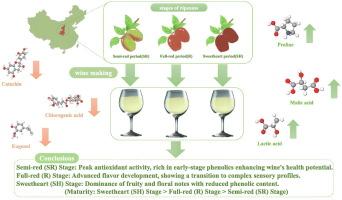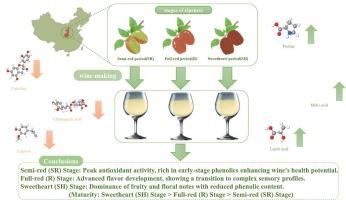成熟期对枣酒化学和感官特征的影响:理化参数、抗氧化活性和挥发性化合物的分析
IF 9.8
1区 农林科学
Q1 CHEMISTRY, APPLIED
引用次数: 0
摘要
研究表明枣成熟度对枣酒的理化性质、抗氧化能力和挥发性有显著影响。半红枣酒中总酚(1069.73 mg GAE/L)和总黄酮(629.82 mg RE/L)含量最高,具有潜在的健康益处。这些含量随着果实成熟而下降,儿茶素、绿原酸和丁香酚浓度显著下降,在半红和全红阶段之间尤为明显。氨基酸浓度,尤其是脯氨酸浓度随着成熟度的增加而显著增加,从半红色阶段的5.93 mg/L增加到甜橙阶段的775.91 mg/L,增强了葡萄酒风味的复杂性。挥发性分析表明,甜心期的芳香谱发生了显著变化,丰富了葡萄酒的果香和花香酯。这些结果强调,选择最佳的成熟度取决于平衡的化学,营养,和感官品质最理想的枣酒,为葡萄酒生产商提供实用的指导方针。本文章由计算机程序翻译,如有差异,请以英文原文为准。


Impact of ripeness stages on the chemical and sensory profiles of jujube wine: An analysis of physicochemical parameters, antioxidant activity, and volatile compounds
This study demonstrates that the jujube maturity significantly affects the physicochemical properties, antioxidant capacities, and volatile profiles of jujube wine. The semi-red jujube wine exhibited the highest concentrations of total phenolics (1069.73 mg GAE/L) and flavonoids (629.82 mg RE/L), underscoring potential health benefits. These levels decreased with fruit maturation, with notable decreases in catechin, chlorogenic acid, and eugenol concentrations, especially evident between the semi-red and full-red stages. Amino acid concentrations, particularly proline, increased significantly with ripeness, from 5.93 mg/L in semi-red stage to 775.91 mg/L in sweetheart stage, enhancing the wine's flavor complexity. Volatile analysis showed significant changes in the aromatic profile at the sweetheart stage, enriching the wine with fruity and floral esters. These results emphasize that the selection of optimal ripeness depends on balancing the chemical, nutritional, and sensory qualities most desired in jujube wine, providing practical guidelines for wine producers.
求助全文
通过发布文献求助,成功后即可免费获取论文全文。
去求助
来源期刊

Food Chemistry
工程技术-食品科技
CiteScore
16.30
自引率
10.20%
发文量
3130
审稿时长
122 days
期刊介绍:
Food Chemistry publishes original research papers dealing with the advancement of the chemistry and biochemistry of foods or the analytical methods/ approach used. All papers should focus on the novelty of the research carried out.
 求助内容:
求助内容: 应助结果提醒方式:
应助结果提醒方式:


